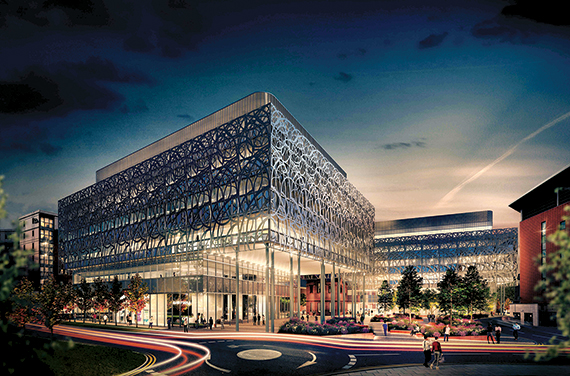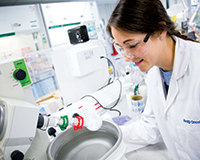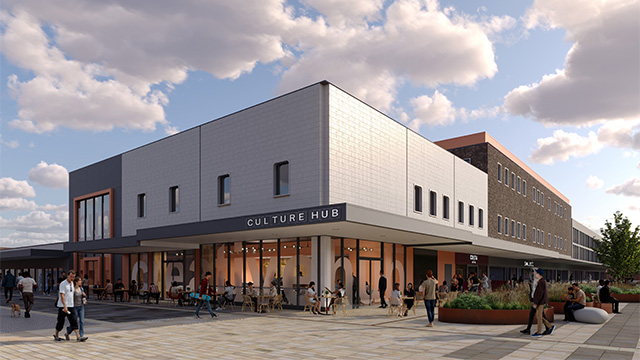
The University of Manchester has more Nobel prize winners on staff than any other UK university and from the discovery of graphene to cutting edge medical advances, investment in innovation has been at the heart of the city’s economic growth.
Theresa May recently announced a further £556m investment in the Northern Powerhouse as part of her industrial strategy, including a £10m life science innovation fund for Manchester and Cheshire. Manchester will welcome any support it can get, but the city has proven that when it comes to the appliance of science, it’s always been in charge of its own agenda.
“We’ve pursued our own industrial strategy here in Manchester for the last 20 years,” says Manchester City Council chief executive Howard Bernstein. “Our key priority over the last decade has been working with the business community, accelerating development and creating ecosystems around key clusters.”
The graphene story
When it comes to the potential for converting academic expertise into products and services, the graphene story is generating the most excitement.
The revolutionary thin and strong 2D material was isolated at the University of Manchester back in 2004.
“It can take 25 to 30 years to go from discovery to commercialisation, but we’re hoping that by fostering early partnerships with business, we can accelerate the process,” says James Baker, business director at the National Graphene Institute.
Manchester’s inward investment agency, MIDAS, has had a number of discussions with overseas organisations in fields such as aerospace and automotive, wanting to tap into the graphene phenomenon.
“These regional assets are a great hook to attract investment,” says MIDAS director of business development Dan Storer.
“The challenge then is to hold onto them so that they go on to manufacture new products in Manchester.”
The challenge for the property industry is to gear up for this potential surge in demand from both science and advanced manufacturing occupiers.
“If the city is successful in commercialising the knowledge coming out of its universities, that will have a big impact on demand for real estate,” says Steve Lang, director of commercial research at Savills. “Bioscience now only accounts for around 3% of office take-up in Manchester, but that could well move into double digits over the next five years.”
The city is already home to a comprehensive mix of innovation-focused real estate. Much of this has been delivered by Manchester Science Partnerships, the UK’s leading science and technology park operator.
Developer Bruntwood is the majority shareholder in the public/private partnership, which operates 3m sq ft of office and laboratory space across its five North West campuses.
Investment strategy
MSP’s portfolio is home to more than 300 health, science and technology businesses. Bruntwood’s director of Strategy, Jessica Bowles, says: “We see investment in supporting the knowledge-based science and technology sectors as central to our strategy moving forward.”
MSP has built on the success of its central Manchester campus and Alderley Park by developing Citylabs, a £25m biomedical centre of excellence within Corridor Manchester, the innovation district stretching down Oxford Road. Opened in 2014, the centre was fully let within 15 months and MSP is now awaiting planning permission to deliver 205,000 sq ft of office and laboratory space in phases 2.0 and 3.0, which is being delivered in a joint venture with Central Manchester Foundation Trust.
Meanwhile, Bruntwood has secured planning consent for Circle Square. The mixed-use development on Oxford Road will incorporate 1.2m sq ft of offices and a £2m technology hub. According to Bowles, much of the commercial space will be “tailored perfectly to companies working innovatively in science, technology, and advanced manufacturing sectors.”
Bruntwood may have the lion’s share of the science occupier market, but as these sectors grow, others will look for a share of the spoils.
David Porter, head of Knight Frank’s Manchester office, says: “As demand filters through, we’ll see a mobilisation of developers seeking opportunities right along the corridor.” However, there are likely to be a number of barriers to entry, not least a shortage of obvious development opportunities.
“The challenge is having oven-ready sites to respond to demand,” says JLL director Ken Bishop. “Occupiers will want to be located along the corridor near the university and there is little land available. They need to think outside the box in finding acceptable locations.”
Where developers source development opportunities space for R&D is a more complex sell to investors.
GVA director Chris Cheap says: “That interface with the institutional investment market may prove difficult. When it comes to offering things like shared lab space and short-term leases, it could be challenging to meet their longer-term income requirements. One way around would be to wrap the covenant of a university or other public body around it and it’s that public/private partnership approach that Bruntwood has used so effectively.”
Flexible space is key
Yet many potential occupiers will have strong covenants themselves and not all have particularly unconventional requirements. For many, the key is accommodating flexible space they can adapt as required. Where there are add-on requirements, such as shared lab space, there will be an opportunity for specialist co-working operators to move in, or for developers to integrate provision within a building used on a pay-as-you-go basis.
CBRE director John Ogden says: “You’re not necessarily looking at expensive specification. It’s more about providing flexible and collaborative environments which have strong IT infrastructures and can accommodate a range of users. In the quest to attract and retain talent, occupiers want to inhabit quality environments.”
Many of the larger pharma and biotech companies have budgets to match their real estate aspirations, although start-ups and SMEs can struggle to afford appropriate grow-on space.
Colliers International’s head of life science UK, Kaleigh Haeg, says: “What’s missing is access to funding to help businesses grow. The £10m funding for Manchester and Cheshire life science announced in the autumn statement will help occupiers pay for fit-outs. That then makes it easier for developers to make these schemes viable.”
Meeting occupier needs
 For developers to exploit the growth of science and advanced manufacturing sectors, they must meet the requirements of businesses at all stages of growth.
For developers to exploit the growth of science and advanced manufacturing sectors, they must meet the requirements of businesses at all stages of growth.
The University of Manchester Innovation Centre is home to around 20 biotech and hi-tech companies. They are provided with the facilities and supportive environment required to help them move onto the next stage of growth.
“But more and more we’re finding that they don’t want to leave us,” says head of UMIC Yvonne Loughlin. “Many say that much of the existing space in the city isn’t appropriate.”
She adds: “They can’t afford to invest in capital infrastructure and do their own fit-outs. Space needs to be at least partially fitted out and offered on a flexible basis. They are generally reliant on grant funding and can’t commit to long leases.”
Loughlin also encourages developers to provide more collaborative space within buildings where occupiers can interact and share equipment.
The desire to cluster and share resources and ideas isn’t exclusive to start-ups. Larger occupiers also expect to network with like-minded businesses within a supportive environment.
In 2016, Redx Pharma consolidated three of its teams in a 74,000 sq ft drug development facility at MSP’s Alderley Park. The company had very specialist laboratory requirements and has taken over space previously occupied by AstraZeneca.
Redx chief executive Neil Murray says: “The great thing about the campus, which has capacity to accommodate 4,000 people, is that we are surrounded by similar businesses. We can all feed off each other. Those networks and interactions are critical.”
Once occupiers are embedded in this type of ecosystem, they are reticent to leave and developers that provide a comprehensive offer will reap the rewards of a loyal occupier base.
The site Sci-Tech Daresbury is home to the STFC Daresbury Laboratory, together with more innovation-linked companies.
Malcolm Jackson, group FD at Langtree and Sci-Tech Daresbury board member, says: “In response to occupier demand, we are developing a Home for Life concept where young companies can start out by renting a desk, then take on a five-year lease on office space, before eventually owning their own building.”











